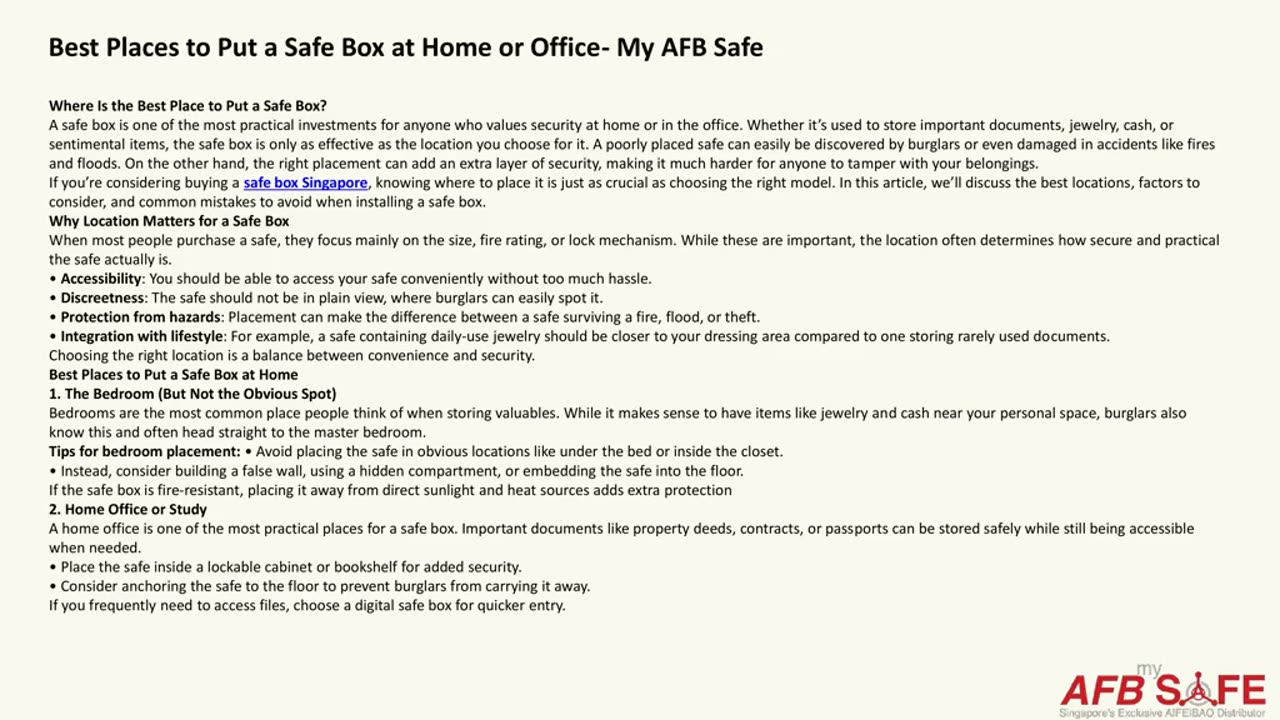Premium Only Content

Best Places to Put a Safe Box at Home or Office- My AFB Safe
Where Is the Best Place to Put a Safe Box?
A safe box is one of the most practical investments for anyone who values security at home or in the office. Whether it’s used to store important documents, jewelry, cash, or sentimental items, the safe box is only as effective as the location you choose for it. A poorly placed safe can easily be discovered by burglars or even damaged in accidents like fires and floods. On the other hand, the right placement can add an extra layer of security, making it much harder for anyone to tamper with your belongings.
If you’re considering buying a safe box Singapore, knowing where to place it is just as crucial as choosing the right model. In this article, we’ll discuss the best locations, factors to consider, and common mistakes to avoid when installing a safe box.
Why Location Matters for a Safe Box
When most people purchase a safe, they focus mainly on the size, fire rating, or lock mechanism. While these are important, the location often determines how secure and practical the safe actually is.
• Accessibility: You should be able to access your safe conveniently without too much hassle.
• Discreetness: The safe should not be in plain view, where burglars can easily spot it.
• Protection from hazards: Placement can make the difference between a safe surviving a fire, flood, or theft.
• Integration with lifestyle: For example, a safe containing daily-use jewelry should be closer to your dressing area compared to one storing rarely used documents.
Choosing the right location is a balance between convenience and security.
Best Places to Put a Safe Box at Home
1. The Bedroom (But Not the Obvious Spot)
Bedrooms are the most common place people think of when storing valuables. While it makes sense to have items like jewelry and cash near your personal space, burglars also know this and often head straight to the master bedroom.
Tips for bedroom placement: • Avoid placing the safe in obvious locations like under the bed or inside the closet.
• Instead, consider building a false wall, using a hidden compartment, or embedding the safe into the floor.
If the safe box is fire-resistant, placing it away from direct sunlight and heat sources adds extra protection
2. Home Office or Study
A home office is one of the most practical places for a safe box. Important documents like property deeds, contracts, or passports can be stored safely while still being accessible when needed.
• Place the safe inside a lockable cabinet or bookshelf for added security.
• Consider anchoring the safe to the floor to prevent burglars from carrying it away.
If you frequently need to access files, choose a digital safe box for quicker entry.
3. Basement or Utility Room
For those who own a house with a basement or utility room, this can be an excellent hiding spot for safes. These areas are usually not the first places burglars search.
However, there are a few things to keep in mind: • Ensure the area is dry and free from moisture to prevent rust or mold damage.
• Elevate the safe or install it on a concrete base to avoid water damage in case of flooding.
If fire safety is a concern, check that the safe has proper fireproof ratings.
4. Behind Artwork or Furniture
Another classic hiding place is behind a painting, mirror, or large furniture like cabinets. While not foolproof, it adds an extra layer of concealment.
• Make sure the furniture is heavy enough that burglars cannot simply move it aside.
• Choose a safe that blends with the wall to make it less noticeable.
This option works best for safes that don’t need to be accessed daily.
5. Kitchen or Pantry
Surprisingly, kitchens can also be a good location. Burglars tend to overlook this area when searching for valuables.
• Conceal the safe inside a pantry cabinet or behind shelves.
• Avoid placing it near heat sources like ovens or stoves.
• If storing documents, ensure the safe is fire-resistant to withstand accidental kitchen fires.
Best Places for Safe Boxes in Offices
While homes have plenty of hiding spots, offices require different considerations.
1. Under the Desk (Discreetly)
For quick access to petty cash or important documents, placing a small safe under a desk is convenient.
• Secure it with heavy bolts to the floor.
Position it in such a way that it’s not visible to every visitor who enters the office.
2. Filing Cabinet or Storage Room
If the safe is mainly for document storage, a filing cabinet or storage room can work well.
• Use lockable cabinets to create another layer of security.
For businesses handling sensitive data, a fireproof and tamper-proof safe is essential.
3. Server or IT Room
In modern businesses, data is as valuable as cash. Storing hard drives, backup media, and sensitive data inside a safe placed in the server room ensures both physical and digital security.
Factors to Consider When Choosing Placement
1. Size of the Safe Box
Larger safes are harder to conceal but also more difficult for burglars to carry. Smaller safes are easier to hide but may be stolen if not properly anchored.
2. Weight
Heavier safes are more secure but may not be suitable for certain areas like upper floors without proper reinforcement.
3. Fire and Flood Risk
Safes placed in basements must account for floods, while those in kitchens or near heat sources need fireproofing.
4. Frequency of Use
Daily-use safes should be more accessible, while rarely accessed safes can be hidden deeper.
5. Anchoring Options
Wherever you place the safe, it should be securely bolted to prevent burglars from simply carrying it away.
Common Mistakes to Avoid
• Placing in the master bedroom openly: This is the first place burglars look.
• Not anchoring the safe: Even a heavy safe can be carried away with the right tools.
• Ignoring fire or water risks: Placing a safe in risky locations without considering environmental hazards can lead to damage.
Choosing convenience over security: A safe that is too easy to access may also be too easy to find.
Why a Safe Box Is Essential in Singapore
In a city as dynamic as Singapore, where both residential and commercial properties are packed into urban spaces, the need for secure storage is rising. From HDB flats to landed properties, a safe box offers peace of mind against burglary, fire, or even accidental misplacement of valuables.
When purchasing a safe boxes Singapore, it’s not only about choosing a trusted brand but also about planning the right placement strategy. Combining both ensures that your valuables are protected in all scenarios.
Conclusion
So, where is the best place to put a safe box? The answer depends on your lifestyle, the type of valuables you’re protecting, and the layout of your space. Bedrooms, home offices, basements, and hidden compartments all make good choices, provided you avoid obvious spots and consider fire and flood safety.
In offices, placing safes under desks, in storage rooms, or in IT facilities ensures both convenience and confidentiality.
When choosing a safe box in Singapore, remember that location is just as important as the safe itself. With smart placement, secure anchoring, and proper planning, your safe can provide lasting protection for the things that matter most.
Visits us : https://myafbsafe.com.sg
-
 2:34:12
2:34:12
Spartan
2 hours agoScrims vs Mindfreak and then Ranked or another game idk
161 -
 1:35:57
1:35:57
Roseanne Barr
4 hours agoEnd-Time Prophecies REVEALED: Jonathan Cahn’s Warning
130K42 -
 1:08:58
1:08:58
vivafrei
5 hours agoComey INDICTED! Proof Jan. 6 was a FED-SURRECTION! Ostrich Crisis Getting More Attention & MORE!
140K92 -
 LIVE
LIVE
StevieTLIVE
1 hour agoBirthday Bash HYPE Warzone Wins ALL NIGHT
10 watching -
 6:30:53
6:30:53
Dr Disrespect
8 hours ago🔴LIVE - DR DISRESPECT - ARENA BREAKOUT: INFINITE - STORM EVENT
169K9 -
 3:35:23
3:35:23
Barry Cunningham
8 hours agoPRESIDENT TRUMP SPEAKS ON JAMES COMEY INDICTMENT! MORE TO COME! DELICIOUS LIBERAL MELTDOWNS!
66K36 -
 25:59
25:59
Simply Bitcoin
1 day ago $1.95 earnedMichael Saylor Reveals $81T Bitcoin Plan to Cancel National Debt?!
37.6K6 -
 1:33:51
1:33:51
Steve-O's Wild Ride! Podcast
1 day ago $1.68 earnedJohn C. Reilly's Surprising Connection To Jackass (And Beef With Weeman!)
50.9K7 -
 4:03:06
4:03:06
StoneMountain64
5 hours agoBattlefield 6 News and Extraction Gaming
48.1K -
 2:13:30
2:13:30
Side Scrollers Podcast
8 hours agoUK Introduces MANDATORY Digital ID + Dallas ICE Shooting BLAMED on Gaming + More | Side Scrollers
115K11